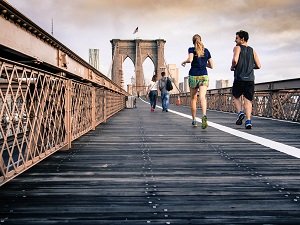 It has been long observed that people who perform physical exercises regularly, are more likely to stay fit and healthy. Thus, the research shows that people who exercise for 45 minutes a day take up to 50% less sick leaves. While the most common reason for staying home is respiratory infections, those who engage in regular physical activity are more immune to diseases caused by those. There is a significant correlation between exercising and catching colds, but it can also be reversed depending on the intensity of exercises. In other words, too much physical activity can be harmful.
It has been long observed that people who perform physical exercises regularly, are more likely to stay fit and healthy. Thus, the research shows that people who exercise for 45 minutes a day take up to 50% less sick leaves. While the most common reason for staying home is respiratory infections, those who engage in regular physical activity are more immune to diseases caused by those. There is a significant correlation between exercising and catching colds, but it can also be reversed depending on the intensity of exercises. In other words, too much physical activity can be harmful.
According to numerous studies, athletes who exercise regularly are less prone to colds and other respiratory diseases. There are various reasons for this. Firstly, physical activity increases blood pressure and intensifies blood circulation. As a result, increased activity is observed in cells that are responsible for immunity. Secondly, along with higher blood pressure, the effect of exercising is also higher body temperature. It is believed that this allows human body to fight harmful bacteria more effectively. Thirdly, regular activity is associated with decreased levels of stress-related hormones.
While it might seem obvious that exercising is the top disease-prevention method, there is an important corrective to be made — it should involve regular sessions of moderate physical activity, usually not more than 40-45 minutes. Much longer periods of uninterrupted exercising, also of higher intensity, are followed by much longer vulnerability periods during which human body can be less immune to diseases.
There is indeed another side of exercising. As a result of intensive physical activity, the body produces cortisol and adrenaline, two complex and essential hormones that can do both good and harm. Cortisol helps maintain homeostasis, to provide the body with additional energy when necessary, and participates in regulation of glucose levels. Adrenaline is also associated with higher blood pressure and increased energy levels. These two hormones are called “stress hormones”, as they are especially advantageous in situations when a person experiences stress. When adrenaline and cortisol are released in small doses, it seasons the body; on the other hand, when these doses are increased, it wears the body out.
Vigorous exercising which is characterized by greater emission of stress-related hormones into the body, can weaken the immune system of athletes for some time. They become particularly susceptible to respiratory diseases and infections. Therefore, it is recommended to use a number of preventive methods to protect their health. This includes: maintaining the optimal levels of vitamins in the body; avoiding crowds and places with lots of people; getting proper amounts of sleep; and avoiding fatigue when training. Under no circumstance should athletes be exercising when they manifest such symptoms as cough with mucus, muscle ache, nausea, or anything “below the neck”. A recovery period should also be no shorter than the sickness period.
Although regular working out tends to make people healthier, it can be also be harmful in increased amounts. Just as well as 40-minute daily exercises help to boost the immunity against respiratory diseases, intensified physical activity makes the body more susceptible to the same infections. While the temporary changes in the immunity is what people should be aware of when they commit to exercising, there is also a whole range of other concerns, such as muscle inflammations, joint injuries, or cardiovascular problems. Therefore, it must be said that exercising makes people fit, but it should be strictly controlled and normalized.
References
- Bouchard C, Shephard RJ, Stephens T, et al. Exercise, fitness, and health: a consensus of current knowledge: proceedings of the International Conference on Exercise, fitness, and health, May 29-June 3, 1988, Toronto, Canada. Web.
- Garber CE, Blissmer B, Deschenes MR, et al. “Quantity and Quality of Exercise for Developing and Maintaining Cardiorespiratory, Musculoskeletal, and Neuromotor Fitness in Apparently Healthy Adults.” Medicine and Science in Sports and Exercise. 2011, 43 (7): 1334-1359.
- Kenney WL, Wilmore J, Costill D. Physiology of Sport and Exercise 6th Edition. Human Kinetics, 2015.
- Khan KM, Thompson AM, Blair SN, et al. “Sport and exercise as contributors to the health of nations.” The Lancet. 2012, 380 (9836): 59–64.
- Penedo FJ, Dahn JR. “Exercise and well-being: a review of mental and physical health benefits associated with physical activity.” Current Opinion in Psychiatry. 2005, 18 (2): 189-193.
- Shephard RJ. “Physical activity and reduction of health risks: how far are the benefits independent of fat loss?” The Journal of Sports Medicine and Physical Fitness.1994, 34 (1): 91-98.
- Thompson PD, Franklin BA, Balady GJ, et al. “Placing the Risks Into Perspective: A Scientific Statement From the American Heart Association Council on Nutrition, Physical Activity, and Metabolism and the Council on Clinical Cardiology.” AHA Scientific Statement. Circulation. 2007; 115: 2358-2368.
